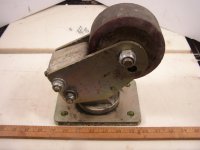Well now that we know you just need to move machine, not keep it on wheels, skates might be the best answer, but from my experience, skates need a pretty smooth floor, and you said concrete was rough.
Northerns with the ball-bearings using the ignorant outer-race as "tires" or my other 10K "straight" Vestils with half the bearings but thicker axles most assuredly need a smooth floor. And I have that, indoors.
The Northern 4400 lb with softer, larger, urethane rollers, or the Vestil 10K swivel-top and a 10k rating need but DE-rating and/or ganging-up to manage soft, patched and uneven rough asphalt on a slight slope. Caterpillar-tracked Hillman (style) skates I had trialed and found less useful than the big fat roller ones, ganged. Those are good enough at "rough" concrete, but just leave more interesting damage patterns when they sink into asphalt and have to be "dug" back out than simpler ones do.
BTW don't expect even rather good plywood to much help. Steel, even thin, or shiney-wood, thicker, as rollerway "highway surfacing" plates, rather.
Casters do not bring any roller goodness to the party that one form of skates or another does not have also. All they do is increase height and put a side-collapse structural risk into the failure-probability calculations.
The most important bearing to a swivel caster is NOT the one the wheel rolls on. It is the swivel bearing, and those love dirt and rust, UNfortunately those are not well-done even brand-new, and too many of them rely on a pivot pin that is upset, rivet style, into place and with sloppy tolerances.
They work "OK" for tool cabinets, a Burke #4 @ 400 lbs, a Panto-Engraver at 300 lbs or a bit less, and maybe up to a BirdPort @ 2K avoir or wotever it is before or after laying a dinosaur egg.
They start to fall over, literally, when side-loads are imposed 'coz a caster failed to re-align or hit a bit of chip or tiny hunk of gravel, and/or the mass goes above the 3K mark and can shift much of its concentration onto but ONE of several casters.
HF or Big-Box stop with casters in their bins at a certain max? That figure, brethren, happens to be right about the pragmatic limit before even heavier ones start to be more pain than gain compared to skates.
Heavier construction gets one a stronger caster. It cannot make them auto-swivel conveniently as those on an office chair are meant to do. And, FWIW? Sometimes FAIL to do, even then.
We have all "BTDTGTTS" on caster problems. We do not have to pay "real money" to find that those problems "scale up", still bite, but much HARDER!
You want good examples? Start with the B-26 bomber and come forward to an Airbus 380 or Big-Bong-Bong Boeing pick-up truck for space shuttles, or an Antonov flying carpark.
Tricyle landing gear. Unbelievable loads.
Only the nose wheel has to steer to get those big-ass birds to and from their gates with a precision but a tiny fraction their own size. A mere foot or three, usually. Possibly dead-nuts with photos, even, a certain part-time boat-builder and 'roo-driver among us takes it on as a challenge.

Go thou and copy shit that JF works, ultralight to Scarebus. Skip the damned airline food, live long and proper.
3 skates worth. And yes, anti-tip skids to go at the corners that do not ORDINARILY touch at all can save yerazz. Not a lot of clearance needed. Can be adjustable bolts. May BE the "operating position" jack-down leveling screws, partially retracted for "travel mode".
Common hardware. Cheap insurance. Why not?







